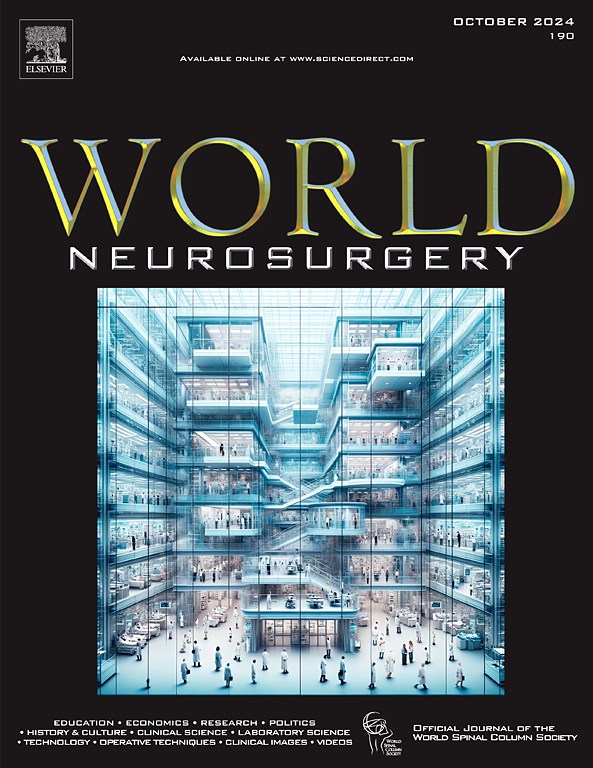Endoscopic Transcortical Tubular-Based Resection of a Third Ventricle Colloid Cyst: Two-Dimensional Operative Video
IF 2.1
4区 医学
Q3 CLINICAL NEUROLOGY
引用次数: 0
Abstract
We present a case of third ventricle colloid cyst surgical resection using a tubular-based endoscopic transcortical approach. Third ventricle colloid are rare benign lesions typically found in the anterolateral part of the third ventricle, close to the foramen of Monro.1 Several surgical approaches have been employed for their management.2, 3, 4 Tubular retractors have been introduced in the neurosurgical practice for their ability to minimize retraction-related injury by distributing retraction forces radially.5, 6, 7 A 35-year-old male with a history of multiple sclerosis presented with severe headache and dizziness. Neuroimaging revealed the presence of left ventricular enlargement. Lesion exhibited a homogeneously high magnetic resonance imaging T2 weighted/T2 weighted fluid attenuated inversion recovery signal with and peripheral enhancement indicative of a colloid cyst. Colloid cyst localized in zone I of the Beaumont classification. A left small frontal craniotomy was performed. A 17-mm diameter ViewSite Brain Access System (Vycor Medical Inc., Boca Raton, Florida, USA) tubular retractor was guided into the left lateral ventricle under neuronavigation. Following controlled decompression of the mucinous content, the cyst capsule was progressively mobilized from critical neurovascular structures and removed. Free communication of the ventricular system was confirmed; therefore, no further maneuver was necessary. No postoperative complications were observed during the postoperative course. Postoperative magnetic resonance imaging on first month confirmed the gross total resection and resolution of hydrocephalus. The endoscopic transcortical tubular-based approach is an effective and safe method for treating colloid cysts. This approach offers the advantages of minimal invasiveness, optimal visualization, and reduced tissue manipulation, establishing a valid method in the management of colloid cysts in the third ventricle.
经皮质小管为基础的内镜下第三脑室胶质囊肿切除术:二维手术影像。
我们提出一个病例的第三脑室胶体囊肿手术切除采用管为基础的内镜经皮质途径。第三脑室胶质是一种罕见的良性病变,通常发生在第三脑室的前外侧,靠近门罗孔。2-4管状牵开器已被引入神经外科实践,因为它们能够通过径向分布牵开力来减少牵开相关的损伤。5-7男性,35岁,多发性硬化症病史,表现为严重头痛和头晕。神经影像学显示左心室增大。病变表现为均匀的高T2/FLAIR信号,周围强化提示胶体囊肿。胶体囊肿定位于Beaumont分类的I区。左额小开颅术。在神经导航下,将直径为17 mm的ViewSite Brain Access System (Vycor MedicalTM)管状牵开器引导至左侧脑室。在有控制的粘液内容物减压后,囊肿囊逐渐从关键的神经血管结构中移动并移除。确认心室系统的自由通信;因此,没有必要采取进一步的行动。术后无并发症发生。术后第1个月MRI证实脑积水大体全切除并消退。内镜下经皮质小管入路是治疗胶质囊肿的一种安全有效的方法。该方法具有微创、最佳可视化和减少组织操作的优点,为第三脑室胶质囊肿的治疗建立了一种有效的方法。
本文章由计算机程序翻译,如有差异,请以英文原文为准。
求助全文
约1分钟内获得全文
求助全文
来源期刊

World neurosurgery
CLINICAL NEUROLOGY-SURGERY
CiteScore
3.90
自引率
15.00%
发文量
1765
审稿时长
47 days
期刊介绍:
World Neurosurgery has an open access mirror journal World Neurosurgery: X, sharing the same aims and scope, editorial team, submission system and rigorous peer review.
The journal''s mission is to:
-To provide a first-class international forum and a 2-way conduit for dialogue that is relevant to neurosurgeons and providers who care for neurosurgery patients. The categories of the exchanged information include clinical and basic science, as well as global information that provide social, political, educational, economic, cultural or societal insights and knowledge that are of significance and relevance to worldwide neurosurgery patient care.
-To act as a primary intellectual catalyst for the stimulation of creativity, the creation of new knowledge, and the enhancement of quality neurosurgical care worldwide.
-To provide a forum for communication that enriches the lives of all neurosurgeons and their colleagues; and, in so doing, enriches the lives of their patients.
Topics to be addressed in World Neurosurgery include: EDUCATION, ECONOMICS, RESEARCH, POLITICS, HISTORY, CULTURE, CLINICAL SCIENCE, LABORATORY SCIENCE, TECHNOLOGY, OPERATIVE TECHNIQUES, CLINICAL IMAGES, VIDEOS
 求助内容:
求助内容: 应助结果提醒方式:
应助结果提醒方式:


